
 |
|
|
Nursery & Forest
Volume 63 Number 18 Date 11/15/2018 NURSERY INSPECTION - The Nursery Program licensed 621 nursery growers and 1,149 retailers this year, with personnel performing 689 site inspections statewide. Annual inspections are prioritized for out-of-state shippers and those holding a Plant Health Certificate. The program's goal is to inspect all licensees at least once every three years. The top 10 pests and disorders found this season were, by total number of detections: virus symptoms, leaf spots, powdery mildew, Japanese beetle, rusts, leafminers, apple scab, potyvirus, anthracnose, and non-viable nursery stock. Summarized below are highlights from the 2018 inspections. -- Shanon Hankin, DATCP Nursery Inspector BOXWOOD BLIGHT - This devastating fungal disease of boxwood was found for the first time in Wisconsin in July, at a Kenosha County production nursery. This led to an extensive delimitation survey and the collection of 165 Buxus and Pachysandra samples from the nursery and its satellite nurseries. The samples were screened with microscopy at the PIB Lab and the initial positive verified by the USDA Mycologist. Two blocks of one field in the Kenosha County nursery were found to have boxwood blight. All infected plants were destroyed and the blocks scorched to eradicate the pathogen. Surrounding production blocks were placed on hold pending monitoring and re-inspection in 2019. Independent from the Kenosha find, another potential introduction occurred on the boxwood variety "Graham Blandy," grown out of state and distributed by a Midwest big box store. The variety was recalled from eight Wisconsin locations. Another 39 suspect boxwoods were pulled from 15 other Wisconsin nurseries, bringing the total to 204 samples tested this season. None of the additional samples and nurseries were positive for boxwood blight. The majority were infected with other common boxwood diseases such as Volutella blight, Macrophoma blight, and Fusarium wilt. In response to the recent boxwood blight cases, nurseries in Wisconsin are encouraged to enter into a Boxwood Blight Cleanliness Program Agreement with DATCP (contact Elizabeth.Meils@wisconsin.gov). The agreement is based on best management practices developed cooperatively by industry, researchers and government groups, when boxwood blight first appeared in U.S. in 2011. -- Anette Phibbs, DATCP Plant Pathologist HEMLOCK WOOLLY ADELGID - Hemlock samples from nurseries in Grant, Ozaukee, and Waukesha counties were screened for hemlock woolly adelgid (HWA) and elongate hemlock scale (EHS). No hemlock samples were positive for HWA, though two nurseries in Ozaukee and Waukesha counties were positive for EHS. All EHS-infested hemlocks were removed from sale and either destroyed or treated with dinotefuran before being released. Unlike HWA, EHS is not regulated with an external quarantine in Wisconsin. However, this invasive pest is not known to be established in the state and there is concern for the Christmas tree industry and native hemlocks given its broad host range. -- Renee Pinski, DATCP Forest Entomologist SCALE INSECTS - Routine inspections found a variety of scale insect species on ornamentals and conifers, including elongate hemlock scale, Fletcher scale, hemlock scale, Miscanthus scale, pine needle scale, rose scale, and willow scale. Miscanthus scale (Duplachionaspis divergens) had not previously been found in the state. Infestations were confirmed on Japanese silver grass (Miscanthus sinensis) at two nursery dealers in Milwaukee County and one each in Marathon and Oneida counties. This species is currently established in Florida, and although it seems unlikely that it can overwinter in Wisconsin, DATCP recommends double-bagging and disposing of any plant suspected of being infested with Miscanthus scale. MITES - Populations were noticeably high this year, likely influenced by favorably warm weather. Among the mites observed were species of broad mites, eriophyid mites (gall mites), rust mites, and spider mites, on a variety of herbaceous, coniferous, and deciduous ornamentals. INVASIVE SPECIES RULE - Invasive plants prohibited or restricted in Wisconsin under the Chapter NR 40 Invasive Species Rule were found at 102 nursery locations this season. The most common were Amur maple, Chinese wisteria, Japanese barberry, moneywort, ribbon grass or gardener's garters, and woodland forget-me-not. Nursery managers are advised to review the invasive species rule prior to ordering plants for the 2019 season. The list currently includes 68 prohibited species, 63 restricted species, and 14 split-listed species. One important rule update this year was the expiration of the 3-year phase-out period for restricted herbaceous plants on May 1, 2018. VIBURNUM LEAF BEETLE - An adult beetle was collected in August on an arrowwood viburnum shrub in Kenosha County. Kenosha was the fourth Wisconsin county in which viburnum leaf beetle has been detected since 2009, following Milwaukee, Ozaukee, and Winnebago. LILY LEAF BEETLE - This newly-established invasive beetle was reported in two more counties this season: Langlade and Shawano. Lincoln County is currently the northernmost Wisconsin county in which the lily leaf beetle is known to occur, and Shawano County marks the eastern boundary. The southernmost record of the beetle is from Portage County. Lily leaf beetle was first discovered in the state in 2014, in Marathon County. -- Shanon Hankin, DATCP Nursery Inspector VIRUSES OF ORNAMENTALS - Of the 619 perennials and annuals submitted by inspectors for disease testing this year, 257 or 42% were analyzed by the PIB Lab for 11 different viruses. One hundred sixty-eight or 65% were positive for at least one plant virus. The most common viruses detected were in the potyvirus group, with 87 positives, 73 on Iris alone. Other hosts infected with potyviruses were Freesia, Helenium, Hylotelephium, Hosta, Horseradish, Mandevilla, Narcissus, Sedum, Sidalcea and Tradescantia. Tobacco rattle virus was also prevalent, found in 26 samples, as was hosta virus X, diagnosed in 23 samples. Sixteen plants were positive for an Ilarvirus group test, canna yellow mosaic badnavirus was found on two canna hybrids "Orange chocolate" and "Cannova Yellow," and clematis chlorotic mottle virus was detected on clematis "Hagley hybrid." Tobacco mosaic virus infected angel trumpet "Charles Grimaldi" and lilac leaf chlorosis was found in lilac. Inspectors continued to work with producers and retailers to prevent virus-infected plant material from entering the retail chain. -- Anette Phibbs, DATCP Plant Pathologist EMERALD ASH BORER - DATCP enacted a statewide emerald ash borer (EAB) quarantine on March 30, placing all 72 counties under quarantine, including those with no EAB detections. Although EAB trapping was not conducted this year, reports of EAB infested trees continued to be tracked and validated. An additional 77 new municipal detections within previously infested counties in were made in 2018, with just over 25% of the state's municipalities confirming EAB infestations since 2008. Three new county records were also confirmed: Clark, Kewaunee, and St. Croix. The latest detections were the result of reports from citizens, as well as state and county forestry staff. A total of 51 Wisconsin counties are now infested with EAB. Currently, the most severe EAB damage is concentrated in the southern half of the state (see map below). VELVET LONGHORNED BEETLE - This foreign longhorned beetle, Trichoferus campestris, was first detected in Wisconsin in July 2017 in Milwaukee County. Follow-up surveys were conducted in 2018, with 25 baited traps placed in urban industrial and manufacturing settings across 10 eastern Wisconsin counties, including Brown, Dane, Kenosha, Manitowoc, Milwaukee, Ozaukee, Racine, Rock, Sheboygan, and Washington. A total of 75 beetles were collected in nine traps, all in Milwaukee County in July and August. Continued trapping is planned for 2019 since the environmental and economic impacts from this pest are unknown. WALNUT TWIG BEETLE - A trapping survey to detect the walnut twig beetle (WTB) was conducted at three sawmills in Chippewa, Grant, and Sauk counties. The selected locations receive black walnut logs from out of state, increasing the risk of introduction of this non-native pest into Wisconsin. Nine baited Lindgren funnel traps were set mid-May and monitored through early September, with no beetles found in collection samples. DATCP has conducted WTB detection surveys since an exterior quarantine for thousand cankers disease went into effect in 2011. -- Renee Pinski, DATCP Forest Entomologist GYPSY MOTH - The Gypsy Moth Program set 10,767 traps in 44 central and western Wisconsin counties in 2018. Preliminary data indicate the state total male gypsy moth catch decreased by approximately 29% from 2017 to 2018, with trappers reporting 76,447 moths (7.1 per trap) this season compared to 108,008 moths (9.9 per trap) the year before. The total number of positive traps containing one or more gypsy moths also decreased by about 24%, from 4,263 in 2017 to 3,262 in 2018. Population declines were most noticeable in northern and central Wisconsin, while populations in southern Wisconsin increased moderately or were similar to those of 2017. Program staff attribute these patterns to sustained periods of below-average 2017-2018 winter temperatures in central and northern parts of the state. Burnett County emerged as an outlier from this trend, remaining a gypsy moth hot spot west of the quarantine zone for a second consecutive year. As mentioned, the counts reported above are preliminary. The DATCP Slow the Spread Program treated a total of 76,288 acres at 35 sites in 14 western Wisconsin counties from May 22-July 11. Btk was applied to 24,612 acres and mating disruption covered 51,676 acres. The DNR Suppression Program also treated seven sites totaling 486 acres with Btk in Dane County. There were no eradication sites or NPV treatments this year, and no new counties were added to the 50-county Wisconsin gypsy moth quarantine. -- Michael Falk, DATCP Gypsy Moth Program 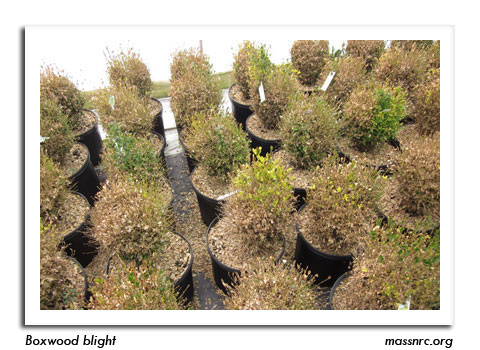
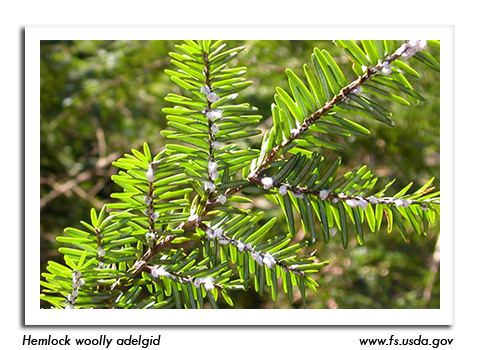
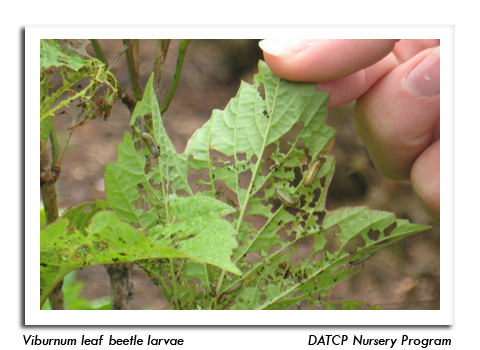
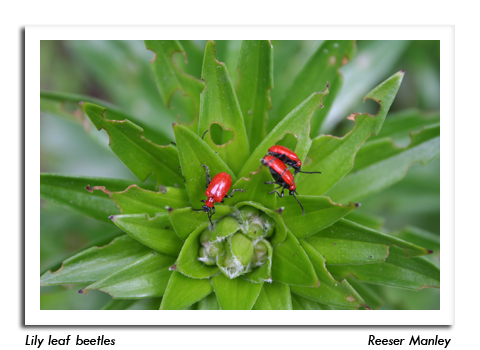

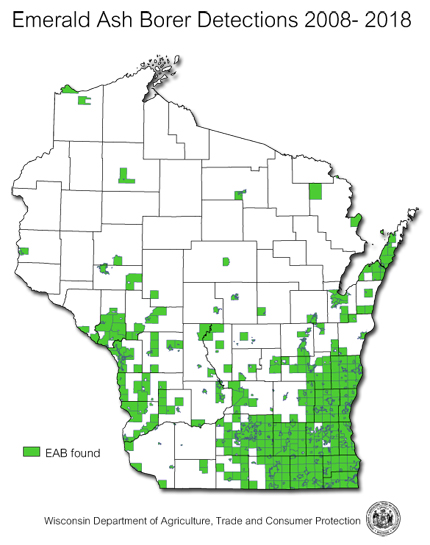
|
|
|